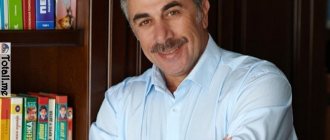Functional speech system article on the topic
Functional speech system
To date, the brain has been studied by thousands of scientists from different countries, its anatomy, physiology, morphological and functional features, the dependence of a person’s mental, intellectual and emotionally volitional abilities on the structure and functions of the brain have been studied.
In Russia, the analysis of the neurophysiological mechanisms of speech, based on the principle of a dynamic system for localizing brain functions, was first formulated by I.P. Pavlov and was further developed in the research of N.A. Brenstein., P.K. Anakhina, A.R. Lurme, A.N. Leontyev. Today, thanks to their works, it has been established that the basis of any higher mental function is not individual “centers,” but complex functional systems that are located in various areas of the central nervous system and at its various levels are united by the unity of working action.
The human brain is organized in such a way that each of the cerebral hemispheres performs (though not immediately) its specific functions. Thus, in a right-handed adult, the right hemisphere differentiates and recognizes all non-speech, objective signs; the occipital lobes are responsible for the visual perception of their diversity of the world: from the perception of individual facial features, features of the entire plant, living and inanimate world; to a huge color palette, all shades of paint, rainbow, etc.
The temporal lobe perceives all non-speech sounds emitted by the world around us: various sounds of water, rustling sounds, wind noise, birdsong, the “voices” of animals, and moreover, the perception of speech intonations, voice timbre, and the whole variety of musical works.
The parietal lobe of the right hemisphere in a right-handed person allows a person to feel the structure of his body, its parts, and takes an active part in kinesthetic self-care skills: walking, running, dressing, etc.
The left hemisphere of a right-handed person is purely speech: the temporal lobe in an adult is “responsible” for the perception of phonemes of the native (and later foreign) language, for auditory-speech memory, “responsible” for the acoustic retention of a series of words in speech memory in order to understand the meaning of the unfolding in the time of the interlocutor's speech. The occipital lobe of the left hemisphere in a right-handed person has the function of recognizing spatially organized symbols: the alphabet, mathematical signs, road signs, that is, this lobe allows you to read and control the written word (text). In a right-handed person, the left parietal lobe performs an extremely important function: it is it that stores in its memory all articulatory skills, all the nuances of pronunciation of soft and hard sounds in combination with vowels or other consonants. In addition, it is the left parietal lobe that stores in its memory the entire human vocabulary, the understanding and use of complex speech patterns (proverbs, sayings, metaphors, the use of prepositions, adverbs and other parts of speech).
And finally, the left frontal lobe of a right-hander organizes the syntax of statements, which unfolds in time, the emotional-volitional sphere, forms the skills of logical thinking, logical behavior, planning and regulation of all our activities. All speech skills are reinforced only with the help of the functions of the frontal lobe.
It is here in the posterior part of the inferior frontal gyrus of the left hemisphere that Broca's center, which is the motor center of speech, is located. When this area is damaged, a disorder of speech motor skills occurs, often accompanied by a violation of general (motor) motor skills.
The child cannot control his speech-motor analyzer, his motor-articulatory images of words change, although sound images are significantly preserved, and the ability to imitate and pronounce oral speech is impaired, although it is relatively well understood.
Here, in the left hemisphere, the posterior third of the superior temporal gyrus, the auditory or gnostic speech center is located - Wernicke's center.
When it is affected, a pronounced symptom is a violation of phonemic hearing, memory, and attention. A child can sometimes speak, repeat what was said, but does not understand the meaning of the words, the speech addressed to him, he cannot carry out this or that instruction, although he hears what is said to him, cannot recognize the names of the object, because does not understand the meaning of the word, does not connect the word with its content.
In an absolute right-handed person, the leading ones are the left ear, eye, hand, and leg. In an absolute left-hander, the leading ones are the right occipital, parietal, temporal and frontal lobes, which implement all the speech and motor skills of this population group.
Various analyzers are related to the functional speech system. Consideration of their anatomical and physiological mechanisms and functions will allow us to carry out a systematic analysis of speech disorders in the future. each analyzer consists of a receptor apparatus that perceives stimulation of the pathways and a central section in the root of the brain, where a higher analysis of the received stimuli occurs.
The human auditory function is performed by the auditory analyzer, the peripheral perceptive apparatus of which is the organ of Corti of the inner ear, followed by the auditory nerves, central pathways and the cortical section of the speech-hearing analyzer, located in the left temporal lobe of the brain (Wernicke's center). The activity of the cortical section of the auditory-speech analyzer is called semantic-discriminating, or phonemic, hearing.
The auditory analyzer is responsible for the conductivity of information, strength, height, duration, sound and timbre of the voice. Recheslukhova for processing the information received, for the correctness of its perception, and phonetic-phonemic analysis. These analyzers work in close interconnection and form a single whole. In this case, the auditory analyzer will play a dominant role, because a child is born with a ready-made sound-perceiving receptor apparatus and from its integrity and usefulness. Under the influence of the surrounding language environment, the speech-hearing analyzer will develop in the process of language acquisition. But, at the same time, with a damaged speech-hearing analyzer, the best physical hearing turns out to be unsuitable for the perception and analysis of even elementary human speech because the perception of even individual speech sounds is not a simple auditory reception, but represents a complex process of interaction of functional systems.
Any deviations in both auditory and speech-auditory functions entail certain deviations in speech development. Moreover, the more their functions are impaired and the earlier the impairment arose, the more noticeable, other things being equal, this is reflected in the acquisition of speech.
How and in what way will be discussed further.
IN AND. Beltyukov in his work “On Children’s Acquisition of Speech Sounds” proves that the development of the speech-auditory analyzer depends not only on the safety of the auditory analyzer, but also on the acoustic properties of sounds, their pronunciation, and on the activity of the speech-motor analyzer, which is also the main component in the functional speech system. The speech motor analyzer performs the functions of static and dynamic coordination of movements and is responsible for the accuracy of pronunciation and prosody.
The formation of pronunciation depends on the capabilities of the speech motor analyzer. it is based on the articulatory properties of sounds.
The development of the speech motor analyzer is based primarily on the degree of articulatory contrast of sounds and the degree of complexity of their pronunciation, as well as the proximity of the articulation of these sounds to motor unconditional reflex reactions.
The speech motor analyzer develops through a gradual transition from coarse differentiations to increasingly subtle differentiations.
The activity of the speech motor analyzer is carried out by a complex system of organs in which peripheral and central speech apparatuses are distinguished. The central speech apparatus is located in the brain. It consists of the cerebral cortex (mainly the left hemisphere), subcortical ganglia, pathways, brainstem nuclei (primarily the medulla oblongata) and nerves going to the respiratory, vocal and articulatory muscles. The functions of the brain regarding speech are described above. The importance of the subcortical nuclei lies in the control of rhythm, tempo and expressive speech.
The pathways connect the cerebral cortex with the peripheral organs of speech by two types of nerve pathways: centrifugal and centripetal.
The centrifugal path begins in the cerebral cortex in Broca's center and goes to the muscles that regulate the activity of the peripheral speech apparatus. Conversely, from the periphery to the center there are centripetal pathways that begin in the proprioceptors and baroreceptors. Proprioceptors are located inside and on the articular surfaces of moving organs.
Proprioceptors are excited by muscle contractions. Thanks to proprioceptors, all our muscle activity is controlled. Baroreceptors are excited by changes in pressure on them and are located in the pharynx. When we speak, the proprio- and baroreceptors are stimulated, which follows a centripetal path to the cerebral cortex. The centripetal path plays the role of a general regulator of all activities of the speech organs.
The cranial nerves originate in the nuclei of the brainstem. All organs of the peripheral speech apparatus are intervened by cranial nerves. The main ones are: trigeminal, facial, glossopharyngeal, vagus, accessory and sublingual.
The trigeminal nerve intervenes the muscles that move the lower jaw; facial nerve - facial muscles, including muscles that carry out lip movements, puffing and retraction of the cheeks; glossopharyngeal and vagus nerves - muscles of the larynx and vocal folds, pharynx and soft palate. In addition, the glossopharyngeal nerve is the sensory nerve of the tongue, and the vagus nerve intersects the muscles of the respiratory and cardiac organs. The accessory nerve intervenes in the muscles of the neck, and the hypoglossal nerve supplies the muscles of the tongue with motor nerves and gives it the possibility of a variety of movements.
Through this system of cranial nerves, nerve impulses are transmitted from the central speech apparatus to the peripheral one. Nerve impulses move the speech organs.
But this path from the central speech apparatus to the peripheral one constitutes only one part of the speech mechanism. Another part of it is feedback - from the periphery to the center.
Now let's turn to the structure of the peripheral speech apparatus (executive).
The peripheral speech apparatus consists of three sections:
- Respiratory, consisting of a system of respiratory muscles of the chest. With the lungs, bronchi and trachea;
- Vocal, consisting of the larynx and the vocal folds located in it;
- Articulation represented by an extension pipe. The supernatus is everything that is located above the larynx: the pharynx, oral cavity and nasal cavity.
The main organs of articulation are the tongue, lips, teeth, jaws (upper and lower), hard and soft palate, alveoli.
When producing speech sounds, the extension pipe performs a dual function: a resonator and a noise vibrator (the function of a sound vibrator is performed by the vocal folds, which are located in the larynx).
The noise vibrator is the gaps between the lips, between the tongue and teeth, between the tongue and the hard palate, between the tongue and the alveoli, between the lips and teeth, as well as the closures between these organs broken by a stream of air.
So, the first section of the peripheral speech apparatus serves to supply air, the second to form the voice, the third is a resonator that gives the sound strength and color and thus forms the characteristic sounds of our speech, arising as a result of the activity of individual active organs of the articulatory apparatus.
All three parts of the peripheral speech apparatus work in systemic interaction. Any disruption in the system of work of departments, any functional anatomical and physiological disorders of the speech apparatus inhibit the function of the speech motor analyzer and adversely affect the speaker’s pronunciation.
So, impulses transmitted along centrifugal paths from the central speech apparatus set the organs of the peripheral speech apparatus in motion. But, for a correct speech act, control of hearing and kinesthetic sensations is necessary. Kinesthetic control allows you to prevent errors and make corrections before the sound is pronounced. Thanks to auditory control, a person hears an error. An impulse telling about an error is sent to the center, from there comes a reverse impulse causing precise articulation. This continues until articulation and auditory control are matched.
In other words, we correctly pronounce only what we can hear, we correctly hear only what we can pronounce.
Thus, the auditory, speech-auditory, speech-motor analyzers work in systemic interaction, complement and correct, or, on the contrary, deepen each other’s defect. This is how the interdependence of the above analyzers appears in the most general form.
The motor analyzer is also related to the functional speech system. Recently, much attention has been paid to the issue of its significance on the formation and development of speech.
Domestic and foreign researchers note that with cerebral palsy, not only the musculoskeletal system, but also speech is seriously affected. EAT. Mastyukova O. This position is confirmed by the data of M.M. Koltsova about the importance of the motor analyzer in the development of a child’s motor and sensory speech. L.V. Fomina examined more than 500 children in various children's institutions and found that the level of speech development is always directly dependent on the degree of development of fine movements of the fingers.
Table 1.
Dependence of the level of speech development
on the degree of development of fine movements of the fingers.
| Degree of development finger movements | Degree of development speeches | Degree of development gross motor skills |
| Norm | Norm | Norm |
| Above normal | Above normal | Above normal |
| Below normal | Below normal | Below normal |
Neuropathologist and psychiatrist V.M. Bekhterev wrote that the function of hand movement is always closely related to the function of speech and the development of the first contributes to the development of the second.
MM. Koltsova and the staff of the Research Institute of Physiology of Children and Adolescents of the Academy of Sciences of the USSR established:
- about a third of the entire area of the motor projection of the brain is occupied by the projection of the hand, which is located next to the projection of the speech motor zone;
- working on the movements of the fingers really stimulates the maturation of the central nervous system, which manifests itself, in particular, in accelerating the development of the child’s speech.
Statement by I.P. Pavlov’s statement that “speech is primarily muscle sensations that go from the speech organs to the cerebral cortex” is confirmed by many researchers of children’s speech. Therefore, when studying the problem of how to stimulate the development of a child’s speech, the idea arose of using muscle sensations from the speech apparatus. Looking at the “map” of the brain, we see that the motor speech area is located very close to the motor area, and the area of the motor projection is occupied by the projection of the hand, located very close to the speech motor area. The size of the projection of the hand and its proximity to the motor speech zone (homonculus - “Penfield’s man”) led many scientists to the idea that training fine movements of the fingers will have a great impact on the development of a child’s active speech.
L.F. Fomina amazingly quickly managed to induce onomatopoeia in 10-month-old children when training fine movements of the fingers (7 times faster than using the traditional method). In further research, she proved that in children the level of speech development is directly dependent on the degree of development of fine movements of the fingers. Until finger movements become free, speech development will not be achieved.
It has also been proven that the development of the motor analyzer has a beneficial effect on the child’s entire body as a whole. The impact of proprioceptive afferentation on brain activity is especially great. The influence of motor activity on the functional state of the brain is expressed in two forms: specific and nonspecific. The first is the direct participation of the motor analyzer in conditioned reflex activity as a component of the effective link of the reflex act. The second is that the movement creates favorable conditions for the development of new temporary connections and the functioning of existing ones.
Scientists have proven that the motor projection of the hand in the cerebral cortex is one speech zone of the brain. This means that there is every reason to consider the hands as an organ of speech, the same as the articulatory apparatus. And in this case, the role of finger movement in relation to speech function can be assessed as specific.
Thus, today scientists have proven several important points regarding the motor analyzer.
- Among the motor functions, the movements of the fingers are of particular importance, since they have a huge impact on the development of the child’s higher nervous activity.
- The function of hand movement is always closely related to the function of speech, and the development of the first contributes to the development of the second.
- The development of the functions of both hands ensures the development of speech “centers” in both hemispheres, and as a result, provides advantages in intellectual development, since speech is closely related to thinking.
- About a third of the entire area of the motor projection of the cerebral cortex is occupied by the projection of the hand, which is located next to the projection of the speech motor zone; finger movements actually stimulate the maturation of the central nervous system, which is particularly evident in the acceleration of the child’s speech development.
- Rhythmic finger movements are a means of increasing the functional state of the cerebral hemispheres and generally enhancing the associative function of the brain.
- The development of articulation of speech sounds in children is greatly facilitated if finger movements are trained.
The visual analyzer is also of great importance in the functional speech system. It is primary in the perception of surrounding reality. Thanks to him, the child observes what is happening and comprehends. He learns about objects by touching them and listening to the sounds they make. The image of the object with its name is gradually fixed. The names of objects and objects of the surrounding reality develop and replenish the child’s vocabulary. The importance of the visual analyzer in the emergence of speech and its perception is confirmed by the fact that children blind from birth begin to speak much later. A sighted child carefully observes the movements of the tongue and lips of speakers, tries to repeat them, and imitates exaggerated articulatory movements well. Limited vision also prevents the full development of general and fine motor skills and motor activity, which, as proven above, in due course inhibits the development of speech.
Thus, between all analyzers there is a system of conditional connections, which is constantly developing and strengthened by repeated connections.
Conclusion: Speech is a higher, complex function of the brain, which is performed by the systemic activity of all cortical analyzers and physiologically consists of the work of the conductive pathways of the central speech apparatus, and according to the feedback principle is regulated through the brain by proprioceptors and baroreceptors.
Literature
- Anokhin P.K. Selected works: Philosophical aspects of the theory of functional systems. – M.: Nauka, 1978. – 400 p.
- Badalyan L.O. Neuropathology. – M.: Asadema, 2000. – 224 – 234 p.
- Becker K.P., Sovak M. Speech therapy. – M., 1981. – P. 11 – 84.
- Beltyukov V.I. Interaction of analyzers in the process of perception and assimilation of oral speech (in normal and pathological conditions) - M.: Pedagogika, 1977. - 176 p.
- Beltyukov V.I. Ways to study the mechanism of speech. // Defectology. – 1984. – No. 4. – 24 – 30 p.
- Zhinkin N.I. Mechanisms of speech. – M., 1958.
FROM THE AUTHOR
The general trend observed in modern linguistics is the development of complex, borderline problems, the development of “adjacent” fields where linguistics works side by side with other sciences, such as sociolinguistics, ethnolinguistics, psycholinguistics; this is a general trend in penetrating “beyond” language, in revealing the essential characteristics of human activity in general, including speech activity; in a word, in studying not so much the language as the speaking person.
This trend largely determined the appearance of this book. Its main idea is the need at the present stage of development of human sciences not to limit the study of speech and language to the framework of one science (for example, linguistics), but to operate broadly, first of all, with such concepts and categories that arise in the course of interdisciplinary research. The ideas reflected in the book were expressed by the author earlier, but here these thoughts, so to speak, are brought together and presented as an integral system. On the pages of this work, the author did not at all seek to merely express his own opinion on the issues raised by him. On the contrary, its task is to introduce the reader to some of the problems that concern linguistic science today, and to give a more or less general idea of the state of these problems. At the same time, the author sought to make his presentation clear and accessible to the general reader, in particular, not to overload the presentation with references to literature (our brochure “Psycholinguistics” (L., 1967) is specifically devoted to the history of the issue, to which the interested reader should turn). In preparing the book, the author used materials from articles and reports, partially published earlier in various publications.
The book consists of four chapters and an appendix. The first chapter addresses the most important theoretical problems of a general nature related to the subject of this book. In the second chapter, the author tries to apply the theoretical principles expressed above to the solution of some specific scientific issues. The third chapter is devoted to psycholinguistics as the science of speech activity. The fourth chapter has a practical focus: it analyzes various issues related to language and grammar teaching. Finally, the appendix contains two historical sketches - about I.A. Baudouin de Courtenay and L.S. Vygotsky. This was done for various reasons. The paragraph about Baudouin was introduced because so far there has been virtually no work on this scientist as a psychologist in the broad sense, as a theorist of speech behavior; Available sources, as a rule, give a wrong picture of this side of his views (as often, however, other sides). The paragraph about L.S. Vygotsky was introduced because now, when the ideas of Vygotsky’s school are intensively penetrating not only psychology, but also related sciences and are also used in linguistics, it is extremely important for the reader, in our opinion, to have the opportunity to familiarize himself in a compact form with the essence of Vygotsky's views.
When writing this book, the author enjoyed the help and friendly support of his colleagues at the Institute of Linguistics of the USSR Academy of Sciences and the Scientific and Methodological Center of the Russian Language. We would like to offer our most heartfelt gratitude to all of them, especially V.G. Kostomarov, who provided great and selfless assistance in working on the manuscript.





